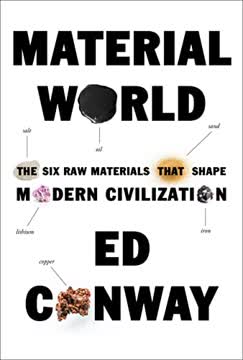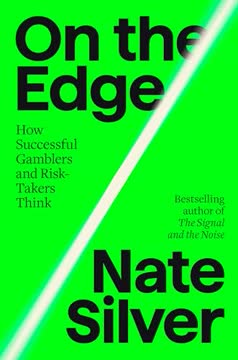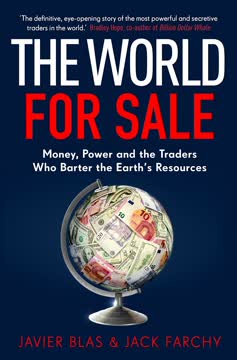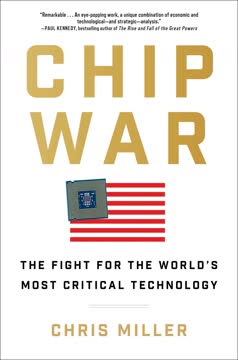نکات کلیدی
1. صنعت نیمههادیها و شکلدهی به دینامیک قدرت جهانی
"تراشهها جغرافیای جهانیسازی را شکل دادند و آسیا و ایالات متحده را به گونهای به هم پیوند دادند که اکنون جدا کردن آنها غیرممکن است."
تأثیر ژئوپلیتیکی. صنعت نیمههادیها به عاملی حیاتی در شکلدهی به دینامیک قدرت جهانی تبدیل شده است. تأثیر آن فراتر از ملاحظات صرفاً اقتصادی است و امنیت ملی، پیشرفت فناوری و روابط بینالمللی را تحت تأثیر قرار میدهد.
تأثیر اقتصادی. زنجیره ارزش جهانی این صنعت شامل تریلیونها دلار تجارت است و تراشهها به عنوان اجزای اساسی در همه چیز از گوشیهای هوشمند تا سیستمهای تسلیحاتی پیشرفته به کار میروند. کشورهایی که بخشهای مختلف صنعت نیمههادی را تسلط دارند، قدرت اقتصادی و فناوری قابل توجهی را در اختیار دارند.
اهمیت استراتژیک. کنترل بر فناوری و تولید نیمههادیها به یک دارایی استراتژیک کلیدی برای کشورها تبدیل شده است. این امر بر قابلیتهای نظامی، رقابتپذیری اقتصادی و استقلال فناوری تأثیر میگذارد. تمرکز این صنعت در مناطق خاص، به ویژه آسیای شرقی، تنشها و وابستگیهای ژئوپلیتیکی جدیدی ایجاد کرده است.
2. از لامپهای خلاء تا مدارهای مجتمع: تولد سیلیکون ولی
"اختراع مدار مجتمع نه تنها الکترونیک بلکه جغرافیای نوآوری را متحول کرد."
انقلاب فناوری. گذار از لامپهای خلاء به مدارهای مجتمع لحظهای محوری در تاریخ فناوری بود. این تغییر امکان کوچکسازی الکترونیک را فراهم کرد و راه را برای انقلاب دیجیتال هموار ساخت.
ظهور سیلیکون ولی. توسعه مدارهای مجتمع باعث تولد سیلیکون ولی به عنوان مرکز جهانی نوآوری فناوری شد. شخصیتهای کلیدی مانند ویلیام شاکلی، رابرت نویس و گوردون مور نقشهای مهمی در این تحول ایفا کردند.
- آزمایشگاه نیمههادی شاکلی: در سال 1956 تأسیس شد و استعدادهای برتر را جذب کرد
- نیمههادی فیرچایلد: در سال 1957 توسط "هشت خائن" تأسیس شد
- اینتل: در سال 1968 توسط نویس و مور تأسیس شد و به یک غول نیمههادی تبدیل شد
اکوسیستم نوآوری. ترکیب منحصر به فرد مؤسسات دانشگاهی، سرمایهگذاری خطرپذیر و روحیه کارآفرینی در سیلیکون ولی، اکوسیستمی بینظیر برای نوآوری فناوری ایجاد کرد و زمینه را برای دههها پیشرفت در نیمههادیها فراهم ساخت.
3. جنگ سرد و تحریک نوآوری در نیمههادیها و زنجیرههای تأمین جهانی
"استراتژی ایالات متحده این بود که ژاپن را به 'فروشنده الکترونیک' تبدیل کند، نه یک رقیب."
کاربردهای نظامی. جنگ سرد سرمایهگذاریهای عظیمی در فناوری نیمههادیها تحریک کرد، زیرا هر دو ایالات متحده و اتحاد جماهیر شوروی به پتانسیل کاربردهای نظامی آن پی بردند. این رقابت باعث پیشرفتهای سریع در طراحی و تولید تراشهها شد.
زنجیرههای تأمین جهانی. برای حفظ برتری فناوری، ایالات متحده توسعه صنایع نیمههادی در کشورهای متحد، به ویژه در آسیای شرقی را تشویق کرد. این استراتژی منجر به ایجاد زنجیرههای تأمین جهانی پیچیدهای شد که تا امروز ادامه دارد.
- ژاپن: تشویق به توسعه الکترونیک مصرفی
- کره جنوبی: حمایت در توسعه تولید تراشههای حافظه
- تایوان: پرورش به عنوان یک مرکز تولید کلیدی
پیامدهای ناخواسته. در حالی که این استراتژی به طور موفقیتآمیزی پیشرفت فناوری شوروی را مهار کرد، همچنین زمینه را برای چالشهای آینده به تسلط نیمههادی ایالات متحده فراهم کرد، زیرا کشورهای متحد صنایع قوی خود را توسعه دادند.
4. صعود و سقوط ژاپن در صنعت نیمههادی
"شرکتهای تراشه ژاپن نه تنها با سیلیکون ولی رقابت میکردند، بلکه آن را خرد میکردند."
صعود سریع. صنعت نیمههادی ژاپن در دهه 1980 به سرعت صعود کرد و تولید تراشههای حافظه جهانی را تسلط یافت. این موفقیت بر پایه حمایت دولتی، فرآیندهای تولید کارآمد و تمرکز بر کیفیت بنا شده بود.
تسلط بر بازار. تا اواخر دهه 1980، شرکتهای ژاپنی مانند NEC، توشیبا و هیتاچی بخش قابل توجهی از بازار جهانی نیمههادی، به ویژه در تراشههای DRAM (حافظه دسترسی تصادفی پویا) را کنترل میکردند.
افول نهایی. با این حال، تسلط ژاپن نسبتاً کوتاهمدت بود. چندین عامل به افول آن کمک کرد:
- سرمایهگذاری بیش از حد در تولید DRAM
- عدم تطبیق با تغییر به سمت ریزپردازندهها
- ظهور رقبا در کره جنوبی و تایوان
- فشار تجاری ایالات متحده و توافقنامه تجاری نیمههادی
5. ظهور تایوان به عنوان یک بازیگر حیاتی در تولید تراشه
"شرکت تولید نیمههادی تایوان (TSMC) به مهمترین شرکتی در جهان تبدیل شده است که اکثر مردم هرگز نام آن را نشنیدهاند."
نوآوری مدل ریختهگری. TSMC، که توسط موریس چانگ در سال 1987 تأسیس شد، مدل "ریختهگری خالص" را پیشگام کرد و تنها بر تولید تراشههای طراحی شده توسط شرکتهای دیگر تمرکز کرد. این مدل صنعت نیمههادی را متحول کرد.
تسلط جهانی. TSMC به بزرگترین تولیدکننده نیمههادی جهان، به ویژه برای تراشههای پیشرفته تبدیل شده است. توانایی فناوری و مقیاس آن، این شرکت را به بخشی ضروری از اکوسیستم فناوری جهانی تبدیل کرده است.
پیامدهای ژئوپلیتیکی. نقش مرکزی تایوان در تولید تراشه پیامدهای ژئوپلیتیکی قابل توجهی دارد:
- ایجاد "سپر سیلیکونی" در برابر تجاوز احتمالی چین
- نگرانیها درباره آسیبپذیری زنجیره تأمین
- تبدیل به نقطه تمرکز در رقابت فناوری ایالات متحده و چین
6. تلاش چین برای استقلال در نیمههادیها تهدیدی برای تسلط ایالات متحده
"شی جینپینگ خواستار آن شده است که چین 'هرچه زودتر در فناوریهای اصلی پیشرفت کند.'"
اولویت استراتژیک. چین استقلال در نیمههادیها را به عنوان یک اولویت ملی کلیدی شناسایی کرده است و وابستگی به تراشههای خارجی را به عنوان یک آسیبپذیری استراتژیک میبیند. این تلاش بخشی از تلاشهای گستردهتر برای تبدیل شدن به یک رهبر فناوری جهانی است.
سرمایهگذاریهای عظیم. دولت چین صدها میلیارد دلار برای توسعه صنعت نیمههادی داخلی خود اختصاص داده است. این شامل:
- ایجاد صندوقهای سرمایهگذاری ملی
- ارائه یارانه به شرکتهای تراشه
- تشویق به انتقال فناوری خارجی
پیامدهای جهانی. جاهطلبیهای نیمههادی چین پیامدهای گستردهای دارد:
- تشدید رقابت فناوری با ایالات متحده
- اختلال در زنجیرههای تأمین جهانی موجود
- نگرانیها درباره کاربردهای نظامی احتمالی تراشههای پیشرفته
7. آینده جنگ: هوش مصنوعی و تراشههای پیشرفته به عنوان میدان نبرد جدید
"کشوری که در هوش مصنوعی پیشرو باشد، بر جهان حکمرانی خواهد کرد."
جنگ مبتنی بر هوش مصنوعی. نیمههادیهای پیشرفته برای توسعه و استقرار سیستمهای هوش مصنوعی در کاربردهای نظامی حیاتی هستند. این شامل سلاحهای خودمختار، سیستمهای هدفگیری پیشرفته و تحلیل بلادرنگ میدان نبرد است.
رقابت قدرت محاسباتی. توانایی پردازش سریع حجم زیادی از دادهها به یک عامل کلیدی در تعیین برتری نظامی تبدیل شده است. این امر منجر به رقابت برای تراشههای قدرتمندتر و کارآمدتر شده است که به طور خاص برای کاربردهای هوش مصنوعی طراحی شدهاند.
فناوریهای دوگانه. بسیاری از نیمههادیهای پیشرفته دارای کاربردهای همزمان غیرنظامی و نظامی هستند و مرز بین فناوریهای تجاری و دفاعی را محو میکنند. این امر تلاشها برای کنترل گسترش فناوریهای حساس را پیچیده میکند و چالشهای جدیدی برای کنترل صادرات ایجاد میکند.
8. تغییرات سیاست ایالات متحده: از "سریعتر دویدن" به مهار فناوری
"رویکرد قدیمی 'سریعتر دویدن' کافی نیست. ما باید آنها را کند کنیم."
تکامل سیاست. سیاست نیمههادی ایالات متحده از تمرکز اولیه بر حفظ برتری فناوری از طریق نوآوری به کار فعال برای مهار پیشرفت فناوری چین تغییر کرده است.
کنترلهای صادراتی. ایالات متحده کنترلهای صادراتی فزایندهای بر فناوریهای پیشرفته نیمههادی اعمال کرده است، با هدف محدود کردن دسترسی چین به تراشهها و تجهیزات تولید پیشرفته.
سرمایهگذاریهای داخلی. با شناخت اهمیت استراتژیک نیمههادیها، دولت ایالات متحده شروع به سرمایهگذاری بیشتر در تولید و تحقیق داخلی تراشه کرده است:
- قانون CHIPS: میلیاردها دلار یارانه برای تولید تراشه در ایالات متحده فراهم میکند
- مرکز ملی فناوری نیمههادی: هدف تسریع نوآوری در تراشهها
9. کمبود جهانی تراشه آسیبپذیریهای زنجیره تأمین را آشکار میکند
"کمبود تراشه نشان داده است که زنجیرههای تأمین نیمههادی چقدر شکننده و جغرافیایی متمرکز شدهاند."
اختلال در زنجیره تأمین. کمبود جهانی تراشه در سالهای 2020-2021 آسیبپذیریهای زنجیره تأمین نیمههادی را برجسته کرد و صنایع مختلف از خودرو تا الکترونیک مصرفی را تحت تأثیر قرار داد.
ریسکهای تمرکز. این کمبود ریسکهای ناشی از تمرکز تولید تراشه در چند منطقه جغرافیایی، به ویژه تایوان و کره جنوبی را آشکار کرد. این امر منجر به درخواستهایی برای تنوع بیشتر مکانهای تولید شده است.
پاسخهای سیاستی. دولتها و شرکتها در سراسر جهان به کمبود با:
- افزایش سرمایهگذاری در تولید داخلی تراشه
- تلاش برای تنوعبخشی به زنجیرههای تأمین
- بازنگری در استراتژیهای موجودی و تأمین پاسخ دادهاند.
آخرین بهروزرسانی::
FAQ
1. What is "Chip War: The Fight for the World's Most Critical Technology" by Chris Miller about?
- History of Semiconductors: The book traces the invention, development, and global spread of semiconductor technology, focusing on how chips became the foundation of modern life, economies, and military power.
- Geopolitical Competition: It explores the intense international competition—especially between the US, China, Japan, Taiwan, and the Soviet Union—to control chip design, manufacturing, and supply chains.
- Key Players and Companies: The narrative highlights the roles of major companies (like Intel, TSMC, Samsung, and ASML) and influential individuals (such as Morris Chang, Andy Grove, and Akio Morita).
- Modern Implications: The book connects historical developments to current events, showing how chip shortages, trade wars, and national security concerns shape today’s world.
2. Why should I read "Chip War" by Chris Miller?
- Understand Global Power Shifts: The book explains how control over semiconductors underpins economic and military power, making it essential for understanding 21st-century geopolitics.
- Insight into Technology’s Role: It reveals how chips are embedded in everything from smartphones to missiles, and why their production is so complex and concentrated.
- Lessons from History: By examining past successes and failures in the chip industry, readers gain perspective on current supply chain vulnerabilities and future risks.
- Engaging Storytelling: Chris Miller combines technical clarity with compelling stories of innovation, espionage, and corporate rivalry, making the book accessible and gripping.
3. What are the key takeaways from "Chip War" by Chris Miller?
- Semiconductors as Strategic Assets: Chips are not just commercial products—they are strategic resources that shape national security, economic growth, and technological leadership.
- Global Supply Chain Fragility: The highly specialized and geographically concentrated chip supply chain is both a marvel of efficiency and a source of vulnerability.
- Innovation and Industrial Policy: Government support, talent migration, and corporate strategy have all played crucial roles in determining which countries and companies lead in semiconductors.
- The New Cold War: The US-China rivalry over chips is a defining feature of modern geopolitics, with export controls, subsidies, and technological decoupling reshaping the industry.
4. How did the semiconductor industry originate and evolve, according to "Chip War"?
- Post-WWII Innovation: The industry began with the invention of the transistor at Bell Labs, followed by the integrated circuit, driven by military and space race needs.
- Rise of Silicon Valley: Key figures like William Shockley, Robert Noyce, and Gordon Moore established the culture and business models that made Silicon Valley the global center for chip innovation.
- Globalization of Manufacturing: As costs rose, companies moved assembly and manufacturing to Asia, especially Taiwan, South Korea, and Japan, creating today’s global supply chain.
- Government and Military Influence: US government funding and procurement, especially for defense, were critical in the early decades, while later, Asian governments used industrial policy to catch up.
5. What is the significance of Taiwan and TSMC in the global chip industry, as described in "Chip War"?
- TSMC’s Founding and Model: Morris Chang founded TSMC in Taiwan, pioneering the “foundry” model—manufacturing chips designed by other companies—which revolutionized the industry.
- Concentration of Advanced Manufacturing: TSMC now produces the vast majority of the world’s most advanced chips, making Taiwan a critical node in the global supply chain.
- Geopolitical Vulnerability: The book highlights how Taiwan’s centrality creates both economic power and strategic risk, especially given tensions with China.
- “Silicon Shield” Concept: Taiwan’s chip industry is seen as a deterrent against conflict, as its destruction would disrupt the global economy.
6. How does "Chip War" explain the US-China rivalry over semiconductors?
- China’s Ambitions: China has invested heavily in building its own chip industry, aiming for self-sufficiency and global leadership, as outlined in policies like “Made in China 2025.”
- US Export Controls: The US has responded with export restrictions on advanced chips and manufacturing equipment, targeting companies like Huawei and SMIC to slow China’s progress.
- Technology Transfer and Espionage: The book details cases of technology transfer, joint ventures, and alleged intellectual property theft as China seeks to close the gap.
- Strategic Stakes: The rivalry is about more than commerce—it’s about military power, economic independence, and the future of global technology standards.
7. What are the main technological and supply chain bottlenecks ("chokepoints") in the chip industry, according to "Chip War"?
- Extreme Concentration: Key stages—like advanced chip manufacturing (TSMC, Samsung), lithography equipment (ASML), and design software (US firms)—are dominated by a handful of companies.
- Export Controls as Leverage: The US and its allies can restrict access to critical tools and software, effectively “choking” rivals’ ability to produce leading-edge chips.
- Vulnerability to Disruption: Natural disasters, pandemics, or conflict in Taiwan could halt global chip production, affecting everything from cars to defense systems.
- Difficulty of Replication: Building new fabs or duplicating advanced equipment takes years and massive investment, making these chokepoints persistent.
8. How did Japan, South Korea, and Europe fit into the semiconductor story in "Chip War"?
- Japan’s Rise and Fall: Japan became a chip powerhouse in the 1980s through government support and manufacturing excellence, but later lost ground to the US and South Korea due to market shifts and strategic missteps.
- South Korea’s Success: Companies like Samsung and SK Hynix, with strong government backing, became global leaders in memory chips, leveraging scale and aggressive investment.
- Europe’s Niche Strengths: While Europe lost out in chip manufacturing, it remains vital in equipment (ASML) and some specialized chip markets.
- Lessons in Industrial Policy: The book contrasts different approaches to government intervention, showing both successes and failures.
9. What are the key concepts and terms explained in "Chip War" by Chris Miller?
- Moore’s Law: The observation that the number of transistors on a chip doubles roughly every two years, driving exponential growth in computing power.
- Foundry Model: A business model where companies like TSMC manufacture chips designed by others, enabling the rise of “fabless” design firms.
- Chokepoints: Critical nodes in the supply chain (e.g., advanced lithography, EDA software) where a single company or country dominates.
- Export Controls and Decoupling: Government policies to restrict technology transfer, aiming to protect national security and maintain technological advantage.
10. How does "Chip War" address the future of the semiconductor industry and potential risks?
- End of Moore’s Law?: The book discusses the slowing of Moore’s Law and the challenges of further miniaturization, requiring new materials and architectures.
- AI and Custom Chips: The rise of artificial intelligence and specialized chips (like GPUs and TPUs) is reshaping the industry and competition.
- Supply Chain Resilience: Governments and companies are investing in domestic manufacturing to reduce dependence on foreign suppliers, but this is costly and slow.
- Geopolitical Flashpoints: The risk of conflict over Taiwan, trade wars, and technological decoupling could disrupt the industry and the global economy.
11. What are some of the most important quotes from "Chip War" and what do they mean?
- “We are competing for everything.” – This quote encapsulates the book’s central thesis: the chip war is about economic, military, and technological supremacy.
- “No one wants to destroy Taiwan’s semiconductor supply chain.” – Highlights the paradox that Taiwan’s importance is both a shield and a source of risk.
- “Chips are the new oil.” – Emphasizes that semiconductors are now as strategically vital as energy resources once were.
- “Weaponized interdependence.” – Refers to how global supply chains can be used as tools of coercion or leverage in international politics.
12. What practical lessons and policy recommendations does Chris Miller offer in "Chip War"?
- Invest in R&D and Talent: Sustained innovation requires investment in research, education, and attracting global talent.
- Diversify Supply Chains: Reducing over-reliance on any single country or company is crucial for resilience.
- Balance Openness and Security: Policymakers must weigh the benefits of global collaboration against the risks of technology transfer to rivals.
- Prepare for Disruption: Governments and businesses should plan for potential shocks—whether from conflict, natural disasters, or technological shifts—to the chip supply chain.
نقد و بررسی
کتاب جنگ تراشهها به دلیل تاریخچه جامع صنعت نیمههادی، بینشهای ژئوپلیتیکی و سبک نوشتاری قابل فهم، تحسینهای بسیاری دریافت کرده است. خوانندگان توضیحات دقیق درباره فناوری تراشه و تأثیر جهانی آن را میپسندند. برخی از سوگیری به نفع ایالات متحده و محتوای تکراری انتقاد میکنند. بسیاری از خوانندگان با توجه به شکنندگی زنجیره تأمین فناوری جهانی و اهمیت استراتژیک تایوان، این کتاب را چشمگشا میدانند. این کتاب به دلیل ارتباطش با تنشهای ژئوپلیتیکی کنونی و بررسی روابط پیچیده بین فناوری، اقتصاد و سیاست مورد ستایش قرار گرفته است.
Similar Books














